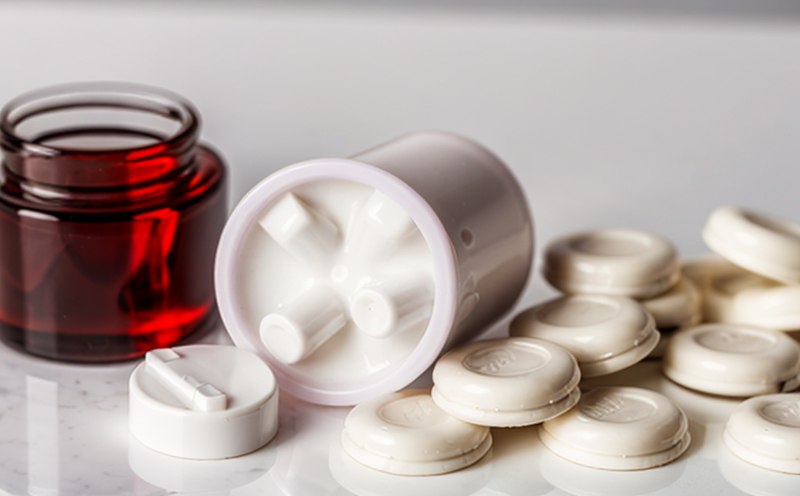USP Tablet Dissolution in Simulated Intestinal Fluid Testing
The USP Tablet Dissolution in Simulated Intestinal Fluid (pH 7.5) test is a critical assessment for ensuring the bioavailability and dissolution profile of oral solid dosage forms, especially those intended for gastrointestinal (GI) tract absorption. This method simulates the conditions that occur in the small intestine to ensure that active pharmaceutical ingredients are released efficiently under physiologically relevant conditions.
The process involves subjecting tablets or capsules to a mixture that mimics the characteristics of intestinal fluids at pH 7.5, which is approximately one hour after ingestion when most drugs undergo significant dissolution and absorption. The apparatus used for this test typically consists of a shaking bath with a specific temperature control (37 ± 0.5°C) designed to simulate physiological conditions accurately.
During the test, the dissolution medium is prepared by dissolving sodium chloride in water until it reaches a concentration equivalent to 15% w/v, which represents the electrolyte content of intestinal fluid. The sample is then agitated vigorously for up to two hours depending on the specific requirements set out in the United States Pharmacopeia (USP) monograph for the product being evaluated.
The dissolution profile obtained from this test provides crucial information regarding drug release kinetics, which can influence therapeutic efficacy and patient compliance. Variations in the rate and extent of drug release may necessitate adjustments to formulation design or process parameters during manufacturing. Compliance with USP standards not only ensures quality but also supports regulatory requirements across various pharmaceutical markets.
Accurate measurement of dissolution at pH 7.5 is essential for predicting how a drug will behave once it enters the GI tract. This test helps identify potential issues such as delayed disintegration or incomplete release, both of which could lead to reduced bioavailability and therapeutic failure. By incorporating this step into their quality control protocols, pharmaceutical manufacturers can enhance product reliability while maintaining high standards of safety and efficacy.
| Key Parameters | Description |
|---|---|
| Temperature Control | 37 ± 0.5°C |
| Dissolution Medium | Sodium chloride in water (15% w/v) |
| Average Agitation Time | 2 hours |
| Test Duration | Up to 4 hours for extended-release formulations |
The importance of precise temperature control cannot be overstated; deviations even as small as ±0.5°C can significantly affect the dissolution rate and therefore the accuracy of results.
In conclusion, USP Tablet Dissolution in Simulated Intestinal Fluid Testing plays a pivotal role in ensuring that oral solid dosage forms meet stringent quality benchmarks set by regulatory bodies like the FDA and EMA. Its significance extends beyond mere compliance; it contributes to improved patient outcomes through enhanced drug efficacy and consistency.
Benefits
The USP Tablet Dissolution in Simulated Intestinal Fluid Testing offers several advantages that are crucial for maintaining high standards of pharmaceutical quality:
- Enhanced Bioavailability: By simulating the conditions found in the small intestine, this test helps ensure optimal drug release and absorption.
- Predictive Value: Results from this test provide valuable insights into potential bioequivalence issues before they become significant problems during clinical trials or post-marketing surveillance.
- Consistency Across Formulations: Ensures that all batches of a given formulation behave similarly, leading to consistent therapeutic effects.
- Regulatory Compliance: Meeting USP standards helps pharmaceutical companies meet international regulatory requirements and gain market access more easily.
These benefits collectively contribute to the development of safer, more effective medications that are reliable for consumers worldwide.
Environmental and Sustainability Contributions
The focus on reducing waste and improving efficiency in pharmaceutical testing aligns closely with broader environmental sustainability goals. By optimizing dissolution tests like the USP Tablet Dissolution in Simulated Intestinal Fluid, laboratories can minimize resource consumption without compromising on quality.
Efficient use of reagents and solvents through precise measurement techniques ensures minimal wastage, while advanced instrumentation allows for more accurate testing, reducing the need for repeat experiments. Additionally, adopting digital reporting methods further reduces paper usage, promoting greener practices within the laboratory environment.
Incorporating these sustainable measures not only supports environmental conservation efforts but also enhances operational efficiency and cost-effectiveness for pharmaceutical companies. Ultimately, such practices contribute positively to both corporate responsibility and industry standards.





